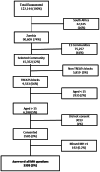Prevalence of mental distress in adults with and without a history of tuberculosis in an urban Zambian community
- PMID: 38161750
- PMCID: PMC10755383
- DOI: 10.1017/gmh.2023.83
Prevalence of mental distress in adults with and without a history of tuberculosis in an urban Zambian community
Abstract
People with tuberculosis (TB) are susceptible to mental distress. Mental distress can be driven by biological and socio-economic factors including poverty. These factors can persist beyond TB treatment completion yet there is minimal evidence about the mental health of TB survivors. A cross-sectional TB prevalence survey of adults was conducted in an urban community in Zambia. Survey participants were administered the five-item Self Reporting Questionnaire (SRQ-5) mental health screening tool to measure mental distress. Associations between primary exposure (history of TB) and other co-variates with mental distress were investigated using logistic regression. Of 3,393 study participants, 120 were TB survivors (3.5%). The overall prevalence of mental distress (SRQ-5 ≥ 4) in the whole study population was 16.9% (95% CI 15.6%-18.1%). Previous TB history was not associated with mental distress (OR 1.20, 95% CI 0.75-1.92, p-value 1.66). Mental distress was associated with being female (OR 1.23 95% CI 1.00-1.51), older age (OR 1.71 95% CI 1.09-2.68) and alcohol abuse (OR 1.81 95% CI 1.19-2.76). Our findings show no association between a previous TB history and mental distress. However, approximately one in six people in the study population screened positive for mental distress.
Keywords: chronic conditions; community; low-income countries; mental distress; mental health.
© The Author(s) 2023.
Conflict of interest statement
The authors have no competing interests to declare.
Similar articles
-
Prevalence of psychological distress and associated factors in tuberculosis patients in public primary care clinics in South Africa.BMC Psychiatry. 2012 Jul 27;12:89. doi: 10.1186/1471-244X-12-89. BMC Psychiatry. 2012. PMID: 22839597 Free PMC article.
-
Tuberculosis prevalence after 4 years of population-wide systematic TB symptom screening and universal testing and treatment for HIV in the HPTN 071 (PopART) community-randomised trial in Zambia and South Africa: A cross-sectional survey (TREATS).PLoS Med. 2023 Sep 8;20(9):e1004278. doi: 10.1371/journal.pmed.1004278. eCollection 2023 Sep. PLoS Med. 2023. PMID: 37682971 Free PMC article. Clinical Trial.
-
Qualitative study of patient experiences of mental distress during TB investigation and treatment in Zambia.BMC Psychol. 2022 Jul 19;10(1):179. doi: 10.1186/s40359-022-00881-x. BMC Psychol. 2022. PMID: 35854324 Free PMC article. Clinical Trial.
-
Tuberculosis.In: Holmes KK, Bertozzi S, Bloom BR, Jha P, editors. Major Infectious Diseases. 3rd edition. Washington (DC): The International Bank for Reconstruction and Development / The World Bank; 2017 Nov 3. Chapter 11. In: Holmes KK, Bertozzi S, Bloom BR, Jha P, editors. Major Infectious Diseases. 3rd edition. Washington (DC): The International Bank for Reconstruction and Development / The World Bank; 2017 Nov 3. Chapter 11. PMID: 30212088 Free Books & Documents. Review.
-
The relationship between mental health and risk of active tuberculosis: a systematic review.BMJ Open. 2022 Jan 6;12(1):e048945. doi: 10.1136/bmjopen-2021-048945. BMJ Open. 2022. PMID: 34992103 Free PMC article.
References
-
- Allwood B, Van Der Zalm M, Amaral A, Byrne A, Datta S, Egere U, Evans C, Evans D, Gray D and Hoddinott G (2020) Post-tuberculosis lung health: Perspectives from the first international symposium. The International Journal of Tuberculosis and Lung Disease 24(8), 820–828. - PubMed
-
- Allwood B, van der Zalm M, Makanda G, Mortimer K, AA FS, Uzochukwu E, Denise E, Diane G, Graeme H and Olena I (2019) The long shadow post-tuberculosis. The Lancet Infectious Diseases 19(11), 1170–1171. - PubMed
Grants and funding
LinkOut - more resources
Full Text Sources

